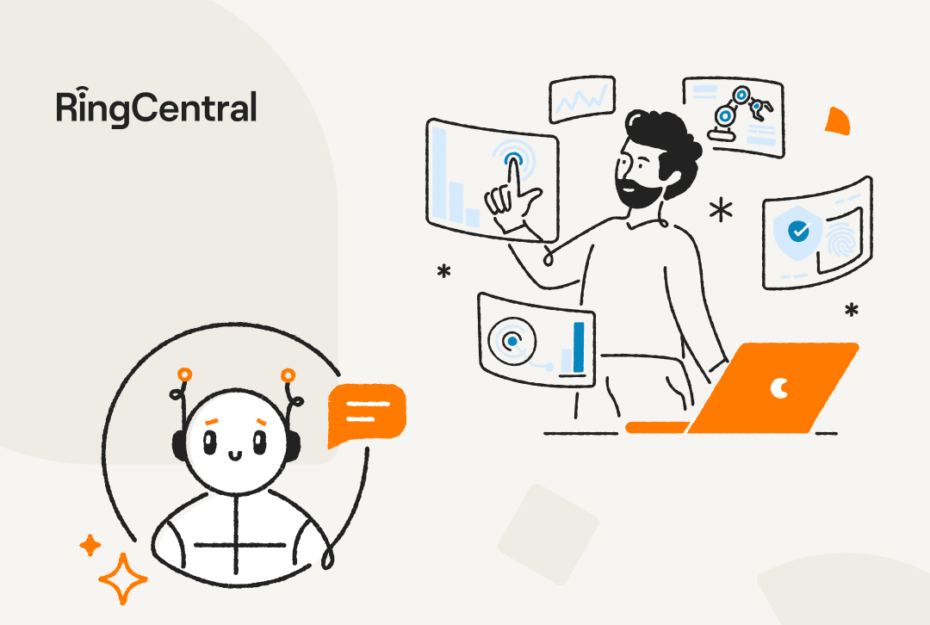Conversational AI and conversation intelligence are two technologies making trends lists across industries this year. Artificial intelligence is primed to make work a lot easier, from how you connect with customers to how you interact with team members in meetings. And while these two terms look similar, they have very little in common beyond the AI that powers them.
In this guide, we’ll dig into what conversational AI and conversation intelligence are, how they’re different, and ways you can use both to work smarter.
Let’s get started:
What is AI, or artificial intelligence?
Artificial Intelligence (AI) covers every aspect of computer science that encompasses teaching machines to think and act like humans. According to a report from BCG Henderson Institute and MIT Sloan Management Review, 85% of employees say they directly benefit from AI in the workplace. Practical use of AI today includes:
- Facial recognition on smartphones
- Personal assistants like Amazon Alexa, Google Home and Siri
- Autonomous AI in smart cars like TESLA
- Generative AI creates original content, like artwork, music, or even sentences and books
- Acting as legal assistants, identifying legal issues in non-disclosure agreements (NDAs)
- Google Maps analysis of the speed of traffic movements
- Fraud protection & fraudulent transactions predictions
What is conversational AI?

Conversational AI is artificial intelligence (AI) that is used to enhance employee and customer experiences in real time.
Conversational AI works on the basis of combining machine learning with natural language processing (NLP) – the linguistic branch of AI. NLP, besides serving chatbots, intelligent virtual agents and voice assistants, can be used in text prediction and grammar checking, sentiment analysis, proactive customer guidance and outreach, automatic summarization, etc.
The most practical examples of conversational AI in the market today are voice-enabled or text-enabled “conversational assistants,” which automatically help customers or customer-facing employees get real-time information they’re seeking without agent intervention, or smart virtual agents that feel, respond and sound like a human conversation, but it is really AI.
What is conversation intelligence?

Conversation intelligence uses artificial intelligence (AI) to analyze business conversations and extract meaningful insights after the fact.
By injecting AI natively into cloud tools, you can identify and replicate top-performing actions, attributes, patterns by analyzing past engagements via calling, messaging or video recordings metadata. These insights serve as the foundation of effective coaching for customer support, sales teams, customer success and can effectively infuse the voice-of-the-customer into your entire organization.
You can apply these conversation intelligence techniques to other use cases as well: for example, operations or legal compliance—the possibilities are endless.
The difference between conversational AI and conversation intelligence
Conversational AI and conversation intelligence tend to be confused with one another, so let’s break down the difference between them:
Conversational AI help people in real-time by offering them voice- or text-enabled assistance. Conversation intelligence analyzes conversations to find insights and other trends that can help improve future conversations.
Here’s an example of the two technologies working together: A virtual assistant (conversational AI) takes a call from a customer who needs help returning at item. Using voice commands, the virtual assistant is able to give the customer the information they need. After the call, the contact center manager reviews the call insights to see how smoothly it went and how satisfied the customer was (conversation intelligence).
Conversational AI vs chatbots: What’s the difference?

The terms conversational AI and chatbots are often used interchangeably, so it’s important to clarify the difference. Basically, conversational AI is an umbrella term for a lot of AI-powered features, including chatbots. But it’s much more than just chatbots.
Conversational AI is the superset of all AI-powered synchronous and asynchronous self-serve options (including chatbots) available to customers, AND real-time guidance, assistance and behavioral coaching options available to customer-centric employees.
There are two primary use cases for Conversational AI:
- Self-service for customers across digital and voice channels
- Real-time guidance and coaching to empower customer-facing employees
Conversational AI brings together artificial intelligence (AI), natural language processing (NLP) and conversational user interfaces (think voice, video,messaging and CX channels) – enabling communication to closely resemble human engagement. Used across various business departments, Conversational AI delivers smoother customer and employee experiences with minimal need for human intervention.
Conversational AI technologies can recognize different languages as well as intent, text and voice semantics, message types (public or private), email metadata, and other information to deliver a seamless and smart call routing experience for your customers.
What’s more, conversational AI technologies can understand both natural speech and unexpected phrases, as well as context through conversational Interactive Voice Response (IVR). They can even show emotion and accents, to better engage with and respond to your customers.
The benefits of conversational AI
Gartner predicts that by 2026, conversational AI will reduce contact center agent labor costs by $80 billion. It is a critical and growing component of customer service, in particular digital self-service, which customers are increasingly adopting.
Conversational AI can be transformational in improving customer satisfaction (CSAT) scores. In a 2021 study conducted by IBM, 99% of companies reported an increase in customer satisfaction due to using conversational AI solutions like virtual agents. Customer-centric companies, depending on their customers, are embracing the use of conversational AI in the form of chatbots, sophisticated virtual agents, text + voice bots, or just voice bots.
The main benefits of conversational AI are:
Reduces labor and other contact center costs
Labor can represent up to 95% of contact center costs, according to Gartner. In the current economic climate, where businesses are striving to decrease expenses, Conversational AI can help as it:
-
- Reduces the need for hiring with easy scalability: Virtual agents can easily be deployed during peak seasons with high traffic to help resolve customer issues without adding new employees.This can significantly lower costs as the average cost of hiring a contact center agent is about $31000 per agent
- Increases productivity: Allows live employees to focus on higher-value activities and improve overall organizational productivity.
- Lowers training costs: Ongoing live guidance and customized behavioral coaching lowers coaching and training costs.
Increases operational efficiencies and revenue
Conversational AI has been shown to increase contact center efficiencies by improving metrics such as average speed of answer, service levels, interaction abandonment rates, customer effort scores and customer retention rates.
Meets modern-world customer needs faster and better
Customer expectations have risen dramatically in recent years and the rules for customer engagement have changed. Conversational AI can help address these changes as follows:
-
- Improves brand loyalty: 86% of consumers said they would dump a brand they trusted after just two poor experiences. Conversational AI ensures fast, consistent and smart self-service in the customer’s channel and language of choice:.
- Provides smart self-serve options: Intelligent virtual assistants (IVAs) and outreach tools that can understand intent and respond to complex queries allow them to do so effectively across channels. What’s more – these sophisticated tools know what they don’t know and can cleverly route the interaction to the right agent with complete custom context including sentiment when needed.
- Offers always-on service: Reactive, company-centric models with service during “normal business hours” no longer cuts it. Customers demand 24 X 7X 365 smart service that is proactive and customer-centric.
Improves employee satisfaction across hybrid and non-hybrid work
Flexible work environments are now here to stay. Conversation AI provides time-saving and stress-busting tools to employees, irrespective of the work environment, in these ways:
-
-
- Reduces manual labor: Repetitive and time-consuming tasks such as filling out forms can now be automated to improve agent experiences and productivity. This results in reduced churn and happier staff.
- Real-time guidance tools empower employees with instant knowledge and soft-skill assistance, making interactions far less stressful.
-
Examples of conversational AI

Conversational AI examples in customer service
Conversational AI can perform routine tasks (such as appointment booking, data collection, payment processing, sending medical reminders etc.) as well as automate sophisticated workflows (such as proactively reaching out to customers based on triggers and completing entire work streams). It can be used across verticals such as:
- Banking and financial services: The global chatbot market in banking, financial services and insurance market is expected to reach $7B in 2030. These chatbots can respond to simple questions about balances. In addition, advanced IVAs can automate complex work streams such as checking expenses, transferring money between accounts balances and paying bills.
- Real estate: 78% of prospective home buyers stick with realtors who promptly answer their inquiries. Conversation AI ensures that customers get instant answers to their questions.
- Travel: According to a study posted by Travel Daily News, 75% of customers rely heavily on chatbots to make travel arrangements and 66% of respondents claim they find travel chatbots ‘useful’ when organizing business and leisure travel bookings. Advanced virtual agents do even more than bots to help to automate the entire travel work stream.
- SaaS: Users can now talk to their software instead of clicking through a series of menus or buttons to get the information they need. This can be accomplished by using voice recognition or chatbot technology.
Conversational AI examples for customer-focused employees
Conversational AI empowers staff, such as salespeople and contact center agents, with real-time guidance and behavioral coaching. It rides along with the employee on every voice and digital interaction to provide instant tips on not just what to say, but how to say it in a way that boosts customer sentiment and drives positive business outcomes. Multiple behavioral parameters such as active listening and empathy can be tracked to detect patterns that steer customized coaching.
Conversational AI guides and coaches employees in real time across multiple use cases such including:
- Sales calls: Conversational AI buddies up with salespeople so they can have more informed discussions with prospects in order to drive conversions and revenues.
- Customer service: AI guides customer service personnel on what to say and how to say it to ensure positive customer sentiment and long-term loyalty
- Compliance: Conversational AI provides dynamic scripts and checklists to ensure that legal disclosures are shared with customers to minimize risk from lawsuits.
Conversation intelligence: How it works
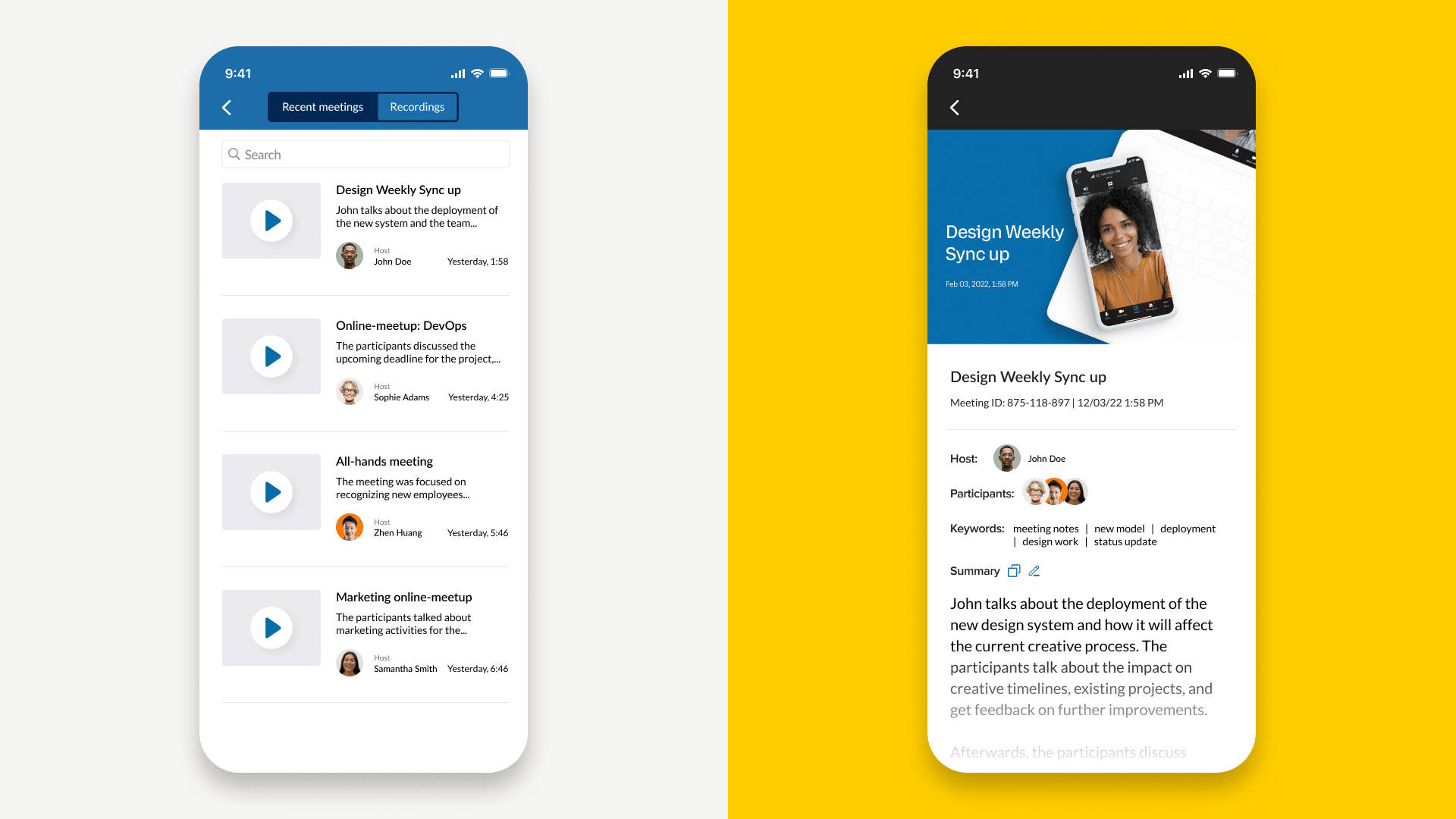
Here at RingCentral, we believe that conversation intelligence is the next major frontier in cloud communications. It reveals new ways to help your employees and managers to do more with less in real time. Plus, it amplifies your ability to create and deliver intelligent connected experiences for customers and employees across multiple channels and endpoints.
Best in class conversation intelligence platforms includes some of the following key capabilities:
- Multi-modal emotion recognition: Recognizes core emotions and sentiments directly from voice. It categorizes the conversations on the emotion cues, such as intensity, pitch and more, to bring emotional awareness insights to participants.
- Multi-speaker recognition and voiceprints: Identifies an individual person based on the unique characteristics of their voice. It also identifies the speaker at precisely the time they spoke during the conversation.
- Speech recognition with accent detection: Converts audio to text by applying powerful neural network models. It recognizes multiple languages and variants to support a global user base with an accent-aware speech recognition that can transcribe a non-native English speaker’s audio with very high accuracy.
2 major benefits of conversation intelligence
There are a lot of business benefits to using conversation intelligence. Here are two that we find especially important:
- Analytics and predictive insights: Standard analytics are also embedded into many of these tools to provide summary statistics and quantitative/qualitative reporting. Predictive analytics, like revenue forecasting, also can enrich the user experience and are used to support critical business decisions.
- Personalized recommendations: With Machine Learning (ML), bots can retain the buyer journey of all customers. This proves to be beneficial when a customer returns to the business. Bots can give personalized perspective to the customers as per their business and help them in decision making.
Examples of conversation intelligence at work
We’re all taking phone calls and meetings all day long and sometimes that poses a few challenges that have been dubbed “meeting overload” or “meeting fatigue”. The good news is, RingCental has created powerful AI powered technology that’s helping us tame our meetings and feel less guilty or behind if a meeting is missed, and allow us to stay productive.
These days, many of us find ourselves more double-booked than ever, and lean on readily available conversational AI technology to help me get “Cliff Notes” type of highlights so we don’t have to spend hours each week catching up on meeting recordings.
Here are six impressive, AI-powered conversation intelligence examples that are available to all RingCentral Video users – even for freemium users!
1. Watch meeting summaries at scale with an AI-generated video highlight reel
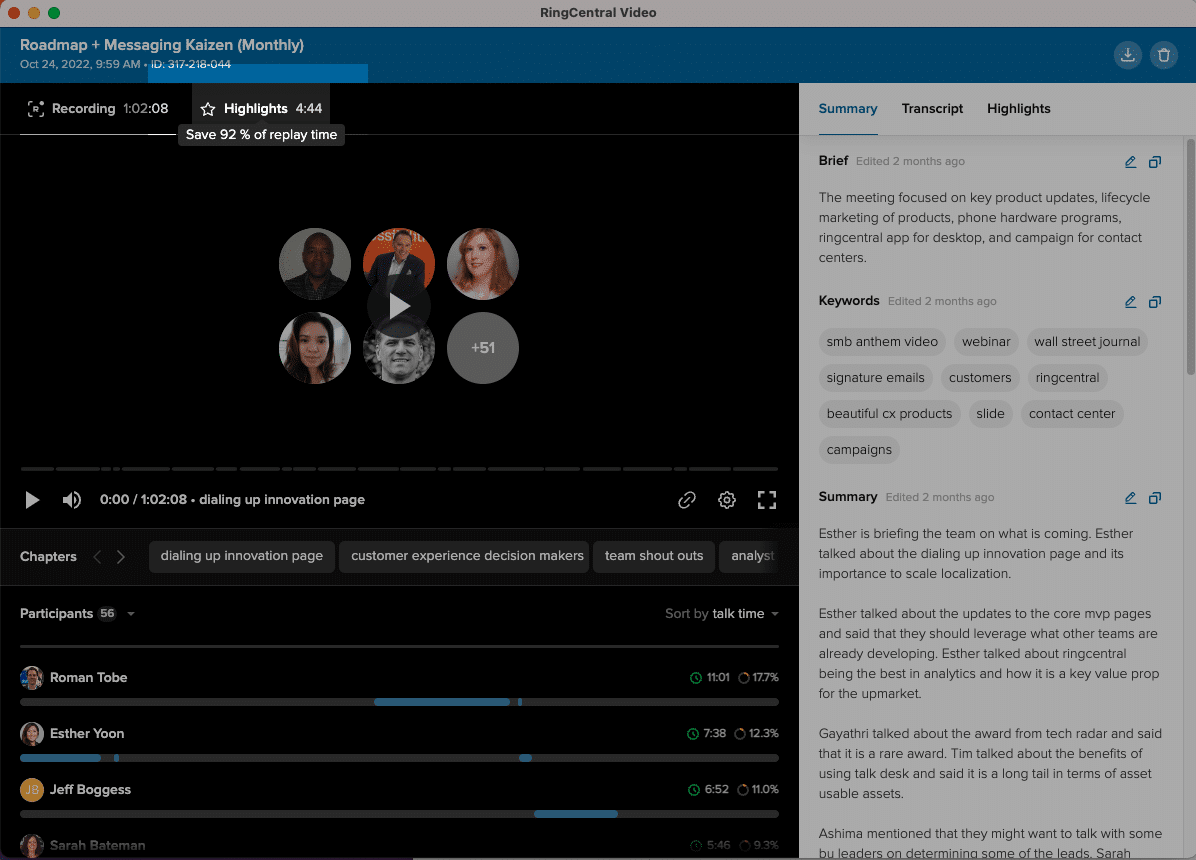
When you miss a Sunday football game, ESPN provides a quick highlight of the big plays that happened – now, you can get the same for your AI powered RingCentral meeting recordings. Sometimes the highlight reel is all you need, vs. spending 1 hour on an entire recording rewatch. Here, you can see that there was a less than 5 minute highlight reel generated alongside a one hour long meeting recording.
2. Search meetings repositories faster by topic, speaker or specific keywords to get the information you need at lightning speed
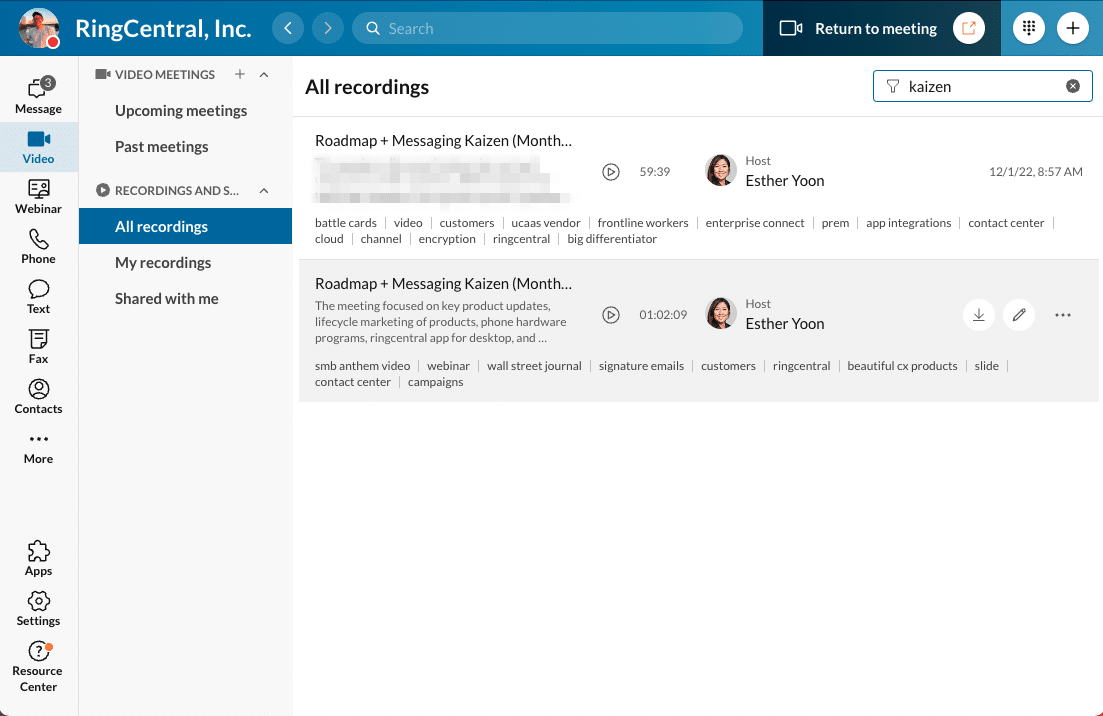
In your library of meeting recordings, the AI powered conversation intelligence engine will detect what was discussed and automatically summarize an abstracted version so you can get a quick snapshot of what was discussed. It even includes a list of key topics so you can glance and mentally sort which recording is relevant for you.
3. Use time efficiently with AI generated meeting cliff notes
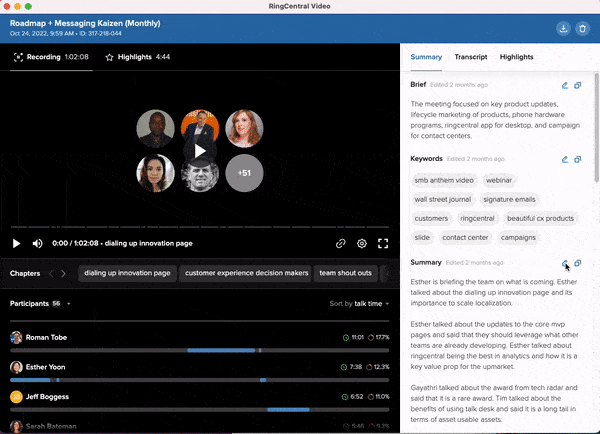
You can literally catch up on what was generally discussed in minutes, without having to watch the entire recording. To scale insights, you need just the right amount of information. If your meeting summaries give too much or too little details, users won’t find them helpful. We have spent considerable time and effort mastering this art. You get a quick description of the meeting, the main keywords that were discussed, which are clickable and take you to specific moments in the video to provide more context, as well as a summary of the meeting.
4. Instantly find relevant content by speaker
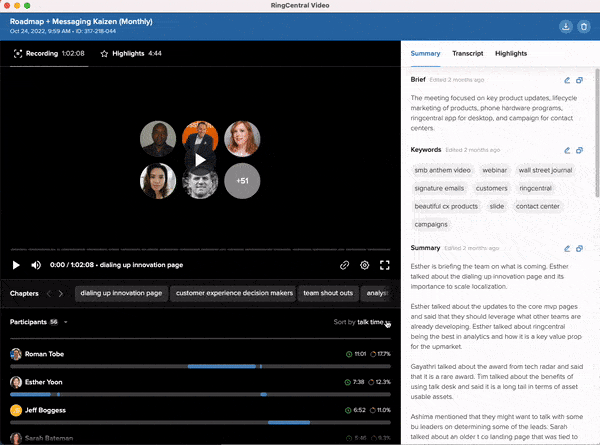
In some meetings where you have many presenters and a jam packed agenda, maybe you want to just find areas of the recording by a specific presenter. For example, in a team meeting, maybe you just want to see the moments where your teammate was presenting on a particular topic. Well, now anyone can do exactly that, further enhancing your productivity by finding the moments you want to recap quickly and even get an analysis of how much or how little a person spoke during a meeting.
5. Save time with AI-generated keywords and quickly share time-stamped URLs with colleagues to jump into the most relevant parts of the recording
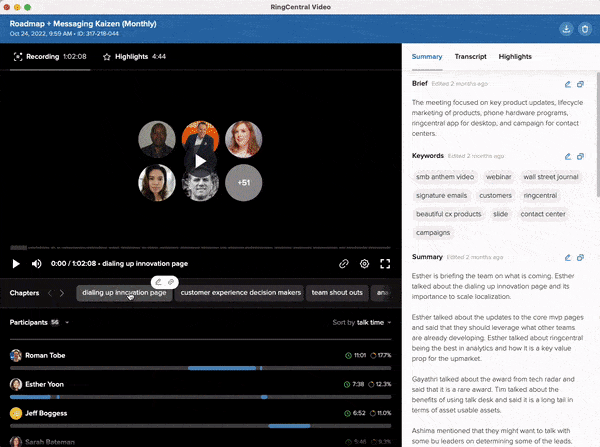
There might be moments when you want more context into a topic that was identified in the summary. Good news is, everything is fully transcribed and linked to relevant parts of the recording. AI-generated keywords and topics also help you easily navigate to the point in the conversation so you can hear verbatim the full context of the conversation. There’s also time-stamped URLs that are generated that you can easily send to a colleague who has access to the recording to make sharing and viewing simpler for everyone.
6. Amplify post-meeting productivity: Dive into the transcript and quickly filter for important phrases or keywords
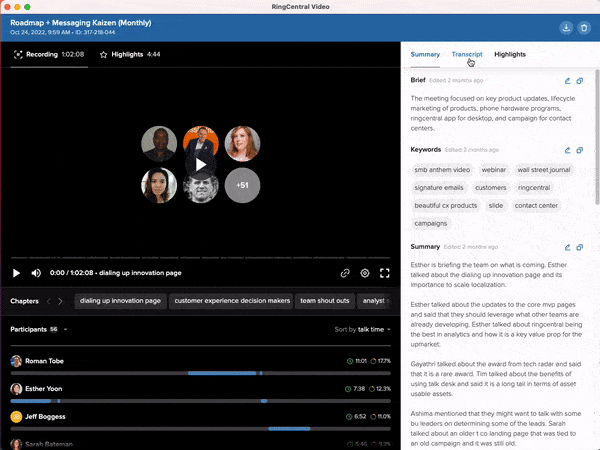
If you’re all caught up using the contextual summary provided by our Conversation Intelligence engine, but want to get more into the weeds into what was exactly discussed, the meeting recording also comes with a meeting transcript, with search functionality that allows you to quickly search by a word or phrase without having to re-read the entire transcript, just like using a Find “ctrl+f” function.
Best of all, transcripts will soon be coming with language support for meetings conducted in different languages, providing more flexibility and support for non-native English speakers!
AI-powered cloud communications: The future is bright
RingCentral’s AI powered conversation intelligence packs a serious punch, especially because we have native access to the metadata needed to make more accurate speaker attribution and separation. That means you get real-time, high-quality transcriptions, summaries and recommendations that can be customized to identify topics with any easy search and filter tool. The great news is, these powerful AI functionalities are available today to all RingCentral customers—yes, even RingCentral Video Pro users!
In addition, RingCentral’s conversational AI platform speeds up and streamlines customer journeys and empowers customer-facing employees across the globe with intelligent and proactive tools. Read our blog to see how it can be used strategically to improve experiences, contain costs and increase efficiencies..
Stay tuned for more AI-powered business communications, conversational AI and conversation intelligence solutions from RingCentral. Subscribe to our blog to keep tabs on how RingCentral progresses on the AI powered cloud communications journey in 2023.
Originally published Jan 17, 2023
Looking For Startup Consultants ?
Call Pursho @ 0731-6725516
Telegram Group One Must Follow :
For Startups: https://t.me/daily_business_reads

